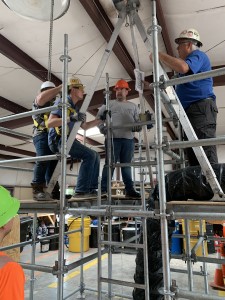Preventative On-Site Fall Protection Training for Workplace Safety
Fall protection training is important. Just look at statistics cited by the CDC: Fall fatalities made up 366 of the 971 total deaths in the construction industry in 2017. Not only do fall fatalities account for 1 in 3 construction deaths, but construction is also the industry in which fall fatalities are the highest. This issue was particularly prevalent in small businesses: companies with 9 or fewer employees accounted for 3 in 5 (61 percent of) construction fall deaths, per the Center for Construction Research and Training (CPWR).
Our fall arrest safety training program will help you prevent fall fatalities among your crew. It will also help to prevent fall injuries. Plus, strong safety training helps to improve morale. Our fall protection training course is directly aligned with the standards from the federal Occupational Safety and Health Administration (OSHA).
What to Expect
 Falls from ladders, scaffolds, and roofs represented 2/3 of all construction fall fatalities. Therefore, those three elements of construction sites are central to OSHA fall protection training requirements. We cover the basics of fall protection training across each of those areas. For instance, here are three cornerstones of our ladder safety training:
Falls from ladders, scaffolds, and roofs represented 2/3 of all construction fall fatalities. Therefore, those three elements of construction sites are central to OSHA fall protection training requirements. We cover the basics of fall protection training across each of those areas. For instance, here are three cornerstones of our ladder safety training:
- Always place the ladder up against solid support and on solid footing. Stepladders should never be set up as straight ladders.
- Two ladders should never be spliced together. Materials, boxes, or barrels should not be used to boost a ladder’s height.
- The side rails of straight ladders should extend a minimum of 3 feet beyond the top support point.
Scaffolding safety essentials from our fall protection training program include the following three:
- Always take any leftover materials and tools off the scaffolds at the end of the shift. Materials should not be stockpiled on them.
- Never use a damaged scaffold. Check the scaffolding’s planking, bracing, tie-ins, footings, fastenings, guardrails, and connectors.
- Never climb off end frames or climb cross-bracing, always using the access ladder.
Roof safety is also incredibly critical. A central aspect of our fall protection class section on roofing is the fall restraint or Personal Fall Arrest System (PFAS):
- Body harness – Capable of distributing the forces of fall arrest across the shoulders, chest, waist, pelvis, and thighs, it must also be possible to attach this harness to other PFAS components.
- Anchorage – Electrical conduits, piping systems, standpipes, and vents should not be used as anchorage. Otherwise, structural members do make strong anchorages. It should be possible to connect a deceleration device, lanyard, or lifeline – capable of supporting 5000 pounds – to it.
- Connectors — Locking snap-hooks, buckles, dee-rings, carabiners, and other devices are used to couple together PFAS components.
- Deceleration device — These mechanisms dissipate energy and limit the energy to which employees are at risk during fall arrests. Examples are automatic self-retracting lanyards/lifelines, deforming/tearing lanyards, and rip-stitch lanyards.
Benefits Of A Fall Protection Course
A few reasons OSHA mentions for the importance of basic fall protection training include the following:
- Falls can occur suddenly, with no reaction time.
- On-the-job deaths or serious injuries impact everyone at the worksite.
- Fall hazard protections are often necessary for working at the heights of many construction projects.
Plus, it helps you stay compliant and meet fall protection training requirements, as indicated by OSHA:
- Train employees about workplace hazards in a language they understand.
- Provide free personal protective equipment (PPE).
- Maintain floors in as dry and clean of condition as possible.
- Mitigate all known hazards.
Beyond our training material painstakingly reflecting OSHA regulations, our training style follows federal guidance related to OSHA fall protection training excellence:
- We manage focus, keeping everyone’s attention on the topic at hand, especially if questions get far afield.
- We get everyone involved in the conversation
- We make fall protection site training more engaging by asking about personal experiences with falls.
- We are careful with people’s feelings.
- We do not just lecture but invite questions.
Enroll with AOTC Today!
At AOTC, our training classes are designed to ensure key safety competencies are understood and duplicated by each student. Contact us today to schedule a customized Fall Protection training session for you and your team. We also offer 24/7 emergency spill response services.
